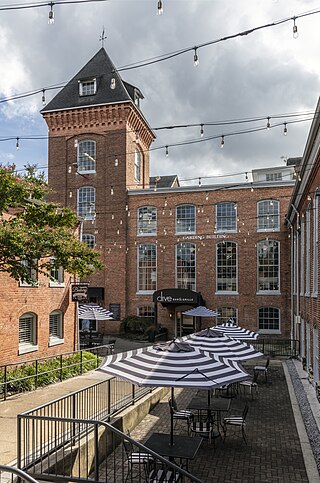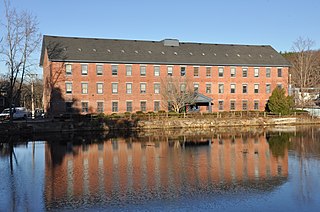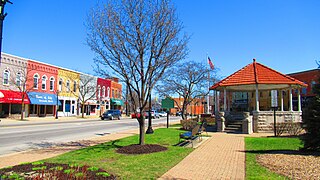
Forest City, formerly known as "Burnt Chimney," is a town in Rutherford County, North Carolina, United States. The population was 7,377 as of the 2020 census, making it the most populous municipality in Rutherford County.

Seneca is a city in Oconee County, South Carolina, United States. The population was 8,102 at the 2010 census. It is the principal city of the Seneca Micropolitan Statistical Area, an (MSA) that includes all of Oconee County, and that is included within the greater Greenville-Spartanburg-Anderson, South Carolina Combined Statistical Area. Seneca was named for the nearby Cherokee town of Isunigu, which English colonists knew as "Seneca Town".

The Savage Mill is a historic cotton mill complex in Savage, Maryland, which has been turned into a complex of shops and restaurants. It was placed on the National Register of Historic Places in 1974. It is located in the Savage Mill Historic District. Buildings in the complex date from 1822 to 1916.

The Ballardvale District in Andover, Massachusetts, encompasses the historic mill village of Ballardvale in the northwestern part of the town. It is centered on the crossing the Shawsheen River by Andover Street, and includes buildings on High Street, Center Street, and other adjacent roads on both sides of the river. The district was listed on the National Register of Historic Places in 1982.

The Downtown Cohoes Historic District takes up 35 acres (14 ha) of the city of Cohoes, New York, United States. Many of the 165 contributing properties date from the 1820-1930 period when the Erie Canal and Harmony Mills were the mainstay of the city's economy. It was recognized as a historic district and added to the National Register of Historic Places in 1984. After years of neglect and decline, it has recently started to see an upswing in business activity due to its historic character and the city's efforts to protect it.

The Dundee Historic Village is a historic district located in Dundee, Michigan. The district was added to the National Register of Historic Places on August 20, 1990. This area is commonly referred to as the downtown area of Dundee and was settled almost concurrently with the Old Village Historic District in nearby Monroe. Both were built in their respective locations due to the River Raisin. Originally, the buildings within the district were small, wood buildings, but these were eventually replaced with two-story, brick storefronts. Most of the surviving buildings were built between 1866 and 1900, although the district traces its origins to Dundee's establishment in 1825.
Earle Sumner Draper was an American town planner and a landscape designer, who is known for coining the term "urban sprawl". He worked under John Nolen.

The Vaucluse Historic District, located in Vaucluse, South Carolina in Aiken County. The district includes the mill, number of accompanying buildings, and over eighty mill village homes. The district is noteworthy in that it is considered to be oldest mill village in the state. No less significant, the mill building, completed in 1877, was based on the plans of engineers A. D. Lockwood & Company of Providence, Rhode Island. The Lockwood successor firm, Lockwood, Greene & Company, would later design around fifty of South Carolina's textile manufacturing facilities. The Vancluse Historic District was listed in the National Register of Historic Places on May 7, 1996.

The North Charlotte Historic District is a 155.5-acre (62.9 ha) national historic district located in Charlotte, Mecklenburg County, North Carolina. The listing included 282 contributing buildings and four contributing structures. It includes work designed by architect Stuart Warren Cramer; it includes Bungalow/craftsman, Late Victorian, vernacular Victorian, reflecting turn-of-the-century mill-village architecture. Located in the district is the separately listed Highland Park Mill No. 3. Other notable buildings include the Mecklenburg Mill, Johnston Mill (1913), Grinnell Manufacturing Company, Hand Pharmacy Building (1904), Lowder Building (1927), the former Highland Inn, Charlotte Fire Department Engine Company No. 9 (1937), and North Charlotte Primary School.

Hope Mills Historic District is a national historic district located at Hope Mills, Cumberland County, North Carolina. It encompasses 61 contributing buildings and 3 contributing sites in the central business district of Hope Mills. Ii includes industrial, commercial, religious, and residential buildings and includes notable examples of Federal and Late Victorian style architecture. Notable buildings include the (former) Hope Mills Manufacturing Company buildings, Rockfish Manufacturing Company, Colin MacRae House, Christ Episcopal Church, Lebanon Masonic Lodge No. 391, and Alice L. Gilbert Store.

Belmont Historic District is a national historic district located at Belmont, Gaston County, North Carolina. It encompasses 264 contributing buildings, 1 contributing site, and 2 contributing structures in the central business district and adjacent residential areas of Belmont. The district was developed after 1873, and includes notable examples of Colonial Revival, Tudor Revival, and Bungalow / American Craftsman architecture. Located in the district is the separately listed U.S. Post Office, Former. Other notable buildings include the R.L. Stowe Mills Office Building, Bank of Belmont (1926), Piedmont and Northern Railroad Depot, Belmont Hotel, Abel C. Lineberger House No. 2 designed by Charles Christian Hook (1870–1938), Samuel Pinckney Stowe House, James W. Stowe House, Sacred Heart College, and Belmont High School (1939).

The Bessemer City Downtown Historic District is a national historic district in Bessemer City, Gaston County, North Carolina. It encompasses 23 contributing buildings and 10 contributing structures in Bessemer City's central business district. The buildings were built between after 1896, and include one- and two-story commercial buildings and two large, sprawling textile mill complexes. Notable buildings include:

Davidson Historic District is a national historic district located at Davidson, Mecklenburg County, North Carolina. The district encompasses 394 contributing buildings, 2 contributing sites, and 2 contributing structures in the central business district and surrounding residential neighborhoods of Davidson and campus of Davidson College. It was developed after 1837 and includes notable examples of Italianate, Greek Revival, and Gothic Revival style architecture. Located in the district are the separately listed Eumenean Hall and Philanthropic Hall. Other notable buildings include the Maxwell Chambers Building, Jackson Row (1928), Helper Hotel (1848), Johnston Grocery Store (1912), Southern Railway Depot (1897), Linden Cotton Factory (1890), Delburg Cotton Mills (1908), Davidson United Methodist Church (1908), Davidson College Presbyterian Church (1951), and Carnegie Library (1909).
Pineville Mill Village Historic District is a national historic district located at Pineville, Mecklenburg County, North Carolina. The district encompasses 77 contributing buildings and 1 contributing site in a residential section of Pineville. It was developed after 1894 and in the 1920s and consists of frame, textile mill houses. The mill village was originally developed by the Dover Yarn Mills and later expanded by the Chadwick-Hoskins Company.

Thomas F. Lloyd Historic District is a national historic district located at Carrboro, Orange County, North Carolina. The district encompasses 25 contributing buildings developed as housing for textile mill workers associated with the 1910 Thomas F. Lloyd Manufacturing Company. The district's buildings date between 1910 and 1915 and are primarily one- and two-story frame mill worker dwellings. A notable dwelling is located at 214 Maple Avenue, which was reportedly built by Thomas Lloyd as a "guest house" for the mill.

Spray Industrial Historic District is a national historic district located at Eden, Rockingham County, North Carolina. It encompasses 70 contributing buildings, 9 contributing structures, and 1 contributing object in an industrial section of the town of Eden. It includes buildings associated with eight textile mill complexes, mill village housing, and seven commercial buildings. Notable contributing resources include the Smith River Dam and Spray Power canal, Morehead Cotton Mill complex, "Superintendent's" House, Imperial Bank and Trust Company (1912), Leaksville Cotton Mills complex, Spray Mercantile Building, Spray Cotton Mills complex, Lily Mill complex, Nantucket Mills complex designed by R. C. Biberstein, American Warehouse Company complex, Rhode Island Mill complex, Phillips-Chatham House, and Spray Woolen Mill complex.

Kesler Manufacturing Co.–Cannon Mills Co. Plant No. 7 Historic District is a national historic district located at Salisbury, Rowan County, North Carolina. The district encompasses 109 contributing buildings and 1 contributing structure consisting of a complex of industrial buildings and mill dwellings. It largely developed between about 1895 and 1930, and includes notable examples of Gothic Revival and Bungalow / American Craftsman style architecture. Notable buildings include the Kesler Manufacturing Company/Cannon Mills complex (1895–1930), Kepley–Trexler House, Henry–Kesler Manufacturing Company House (1910), Kimball–Kesler Mill House (1916), and Morgan–Kesler Manufacturing Company House (1914).

Main Street Historic District is a national historic district located at Forest City, Rutherford County, North Carolina. It encompasses 61 contributing buildings, 1 contributing site, and 1 contributing structure in the central business district of Forest City. The district developed from the late 1880s through the 1920s, and includes notable examples of Classical Revival style architecture. Notable contributing buildings include the U.S. Post Office (1937), the Davis Sisters Building, the Farmers Bank and Trust building (1923), National Bank of Forest City (1923), the Tuberculosis Center (1902), the Romina Theater (1928), the Town Hall (1928) designed by James J. Baldwin, the Blanton Hotel (1925), the Reinhardt Drug Company Building, the First Wesleyan Church (1922), and the Florence Mill (1897-1941).
Wake Forest Historic District is a national historic district located at Wake Forest, Wake County, North Carolina. The district encompasses 245 contributing buildings, one contributing site, and five contributing structures built between about 1890 and 1953 and located in the historic core of the town of Wake Forest. It includes notable examples of Greek Revival and Federal style architecture. Located in the district are the separately listed Lea Laboratory, South Brick House, and the Powell-White House, a contributing resource in the Glen Royall Mill Village Historic District. Other notable buildings include the historic campus of Wake Forest College, Wake Forest Baptist Church (1913), Magnolia Hill (1928), Calvin Jones House, John M. Brewer House, Wait-Taylor House (1843), Taylor-Purefoy-Poteat-Swett House, Community House, St. Catherine of Siena Catholic Church, the Powers Store (1897), and former Water and Light Building (1909).
Glen Royall Mill Village Historic District is a historic mill town and national historic district located at Wake Forest, Wake County, North Carolina. The district encompasses 82 contributing buildings and 1 contributing site built between about 1900 and 1949. It is located in a residential section of the town of Wake Forest. There are notable examples of Bungalow / American Craftsman style architecture. Located in the district is the separately listed Royall Cotton Mill Commissary. Other notable buildings include the Royall Cotton Mill (1899-1900), the Powell-White House (1909-1910), and pyramidal cottages, triple-A cottages, and shotgun houses.




















